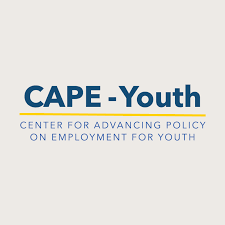By Aidan Harty and Mary Greenfield
In 2019, Governor Mike DeWine of Ohio passed Executive Order 2019-03D, which designated the state as a “model employer” of people with disabilities. Inspired by the executive order, the state’s vocational rehabilitation agency, Opportunities for Ohioans with Disabilities (OOD), launched the Ohio Vocational Apprentice Program (OVAP). OVAP provides people with disabilities, including youth and young adults with disabilities (Y&YAD), valuable on-the-job work experience through paid apprenticeships with state agencies.
During this inaugural Youth Apprenticeship Week, May 5–11, 2024, the Office of Disability Employment Policy (ODEP)-funded Center for Advancing Policy on Employment for Youth (CAPE-Youth) highlights the ways states like Ohio have successfully leveraged apprenticeship programs to create sustainable career pipelines for young people.
Apprenticeship and pre-apprenticeship programs provide important opportunities for Y&YAD to explore career paths of interest while earning a competitive wage. In Ohio, OVAP apprentices are paid a minimum of $16.50 per hour, funded through OOD, for approximately 25 hours of work per week at a maximum of 1,000 hours throughout their apprenticeship. To date, the program has placed 80 Ohioans with disabilities in apprenticeships across 29 state agencies in career pathways such as customer service, human resources, information technology, finance, graphic design, mail processing, food service, and office professional services.
To help policymakers better understand Ohio’s success, CAPE-Youth recently spoke with Jon Hackathorn, the administrator of the OOD program, about the program’s origins and the factors that have led to its continued success.
Support from the Top
Although it did not directly create OVAP, Hackathorn credits Governor DeWine’s 2019 executive order as the inspiration for the program and a continuing impetus for state agencies to foster inclusivity. “Ohio Governor DeWine is a strong supporter of the program,” says Hackathorn, adding that OOD Director Kevin L. Miller sits on the Governor’s cabinet and keeps the program in front of state leadership.
“It has to begin with the leadership of the state,” Hackathorn says. “Executive Order 2019-03D is something that is leading all of these agencies to be inclusive of individuals with disabilities and [to be] a model employer.”
Working Together
Collaboration is another feature crucial to the program’s success. OOD partners with the Department of Administrative Services and other state agencies to provide diverse opportunities to OVAP participants. Hackathorn meets at least once a month with state talent acquisition staff to share emerging opportunities as agency vacancies become available. Through these efforts, the program has expanded to include apprenticeship opportunities with the Ohio General Assembly and statewide elected officials.
Read the State Exchange on Employment & Disability (SEED) article highlighting how OVAP’s collaboration efforts contribute to the program’s success.
Positive Reviews
Apprentices’ positive work experiences in state agencies are yet another factor in OVAP’s success. “[T]he program provides individuals with opportunities to improve their skills on the job, and that has been very, very important,” Hackathorn says. As apprentices gain valuable skills, such as task management and requesting accommodations, they often grow in confidence, competence, and contentment.
Hackathorn notes that 30 people who finished the program are currently employed in positions that match their apprenticeship, either in the public or private sector. These individuals are now earning an average of nearly $20 per hour. “We had several people who have utilized our apprenticeship program chime in to endorse it,” Hackathorn says.
Over time, successful program outcomes and apprentices’ positive experiences have prompted state agencies to adopt the program. Positive word of mouth helps market the program.
Innovative Thinking
As other states look to OVAP’s model to implement their own apprenticeship programs for young people with disabilities, Hackathorn advises thinking outside the box. He says agencies should understand their business and operational needs broadly and from multiple angles to identify opportunities to serve individuals with disabilities. “Don’t limit positions to only certain areas of the agency,” Hackathorn says. “There can be multiple opportunities within a state structure that agencies can benefit from having an apprentice.”
The future for OVAP is bright, with staff working to make their 100th apprenticeship placement by 2025. For information about other initiatives in Ohio, check out the OOD website. To stay up to date on other CAPE-Youth publications, follow CAPE-Youth on X @CSG_CAPEYouth and on Facebook at CAPEYouth. To stay up to date on ODEP initiatives follow ODEP on LinkedIn.

